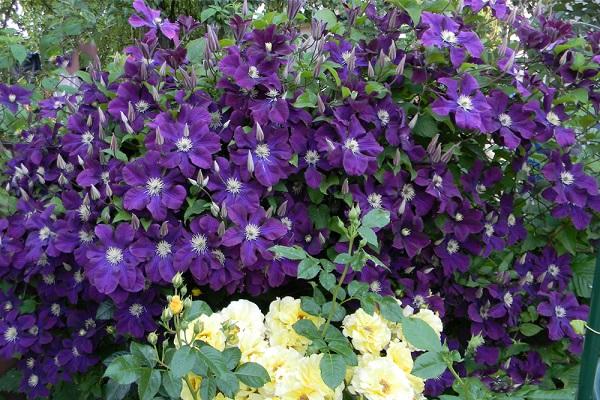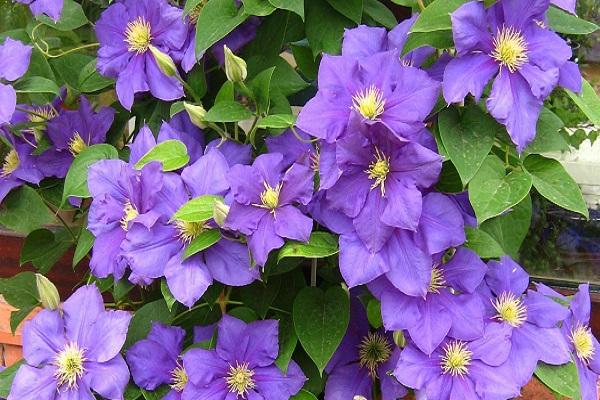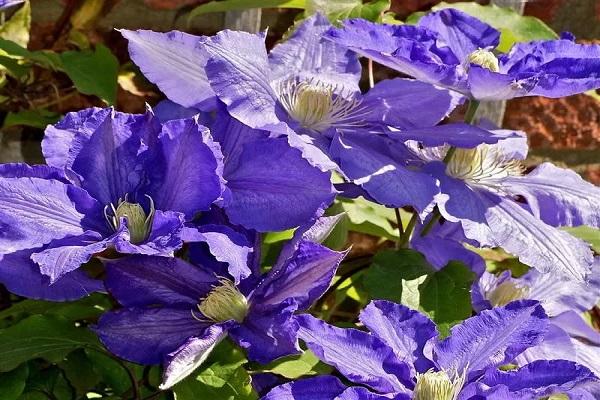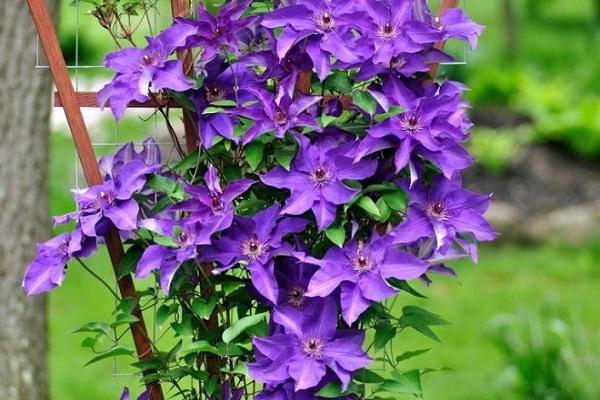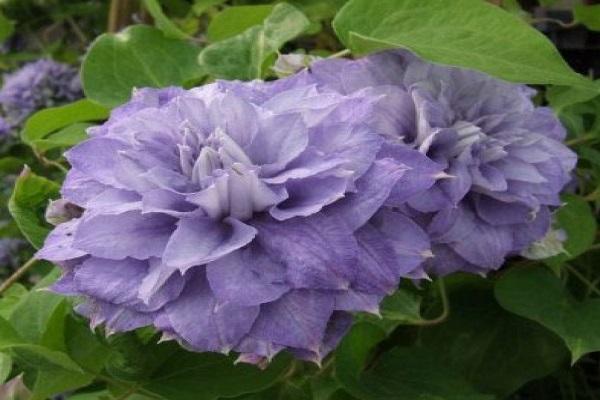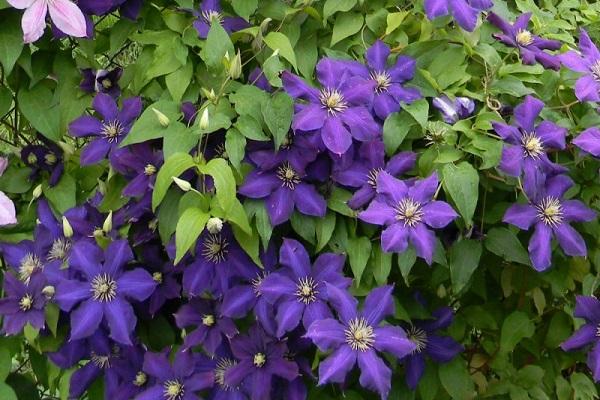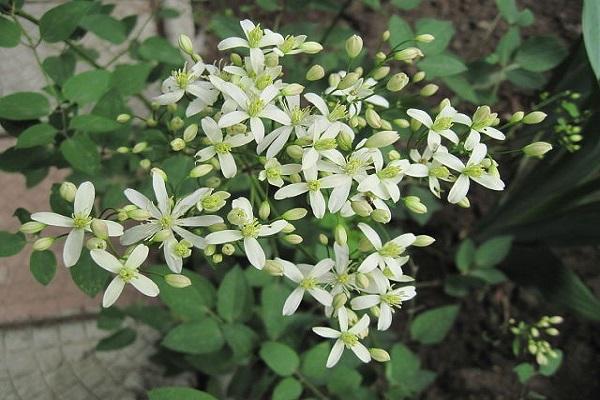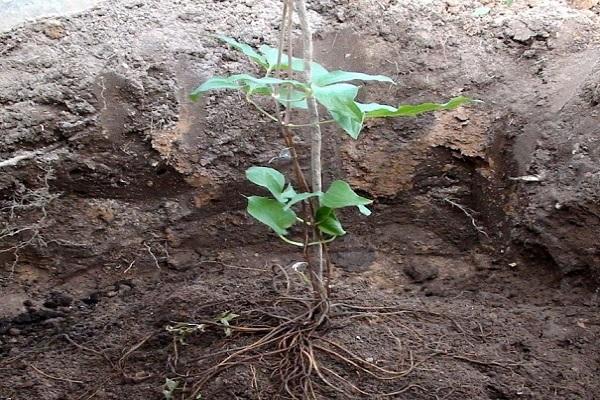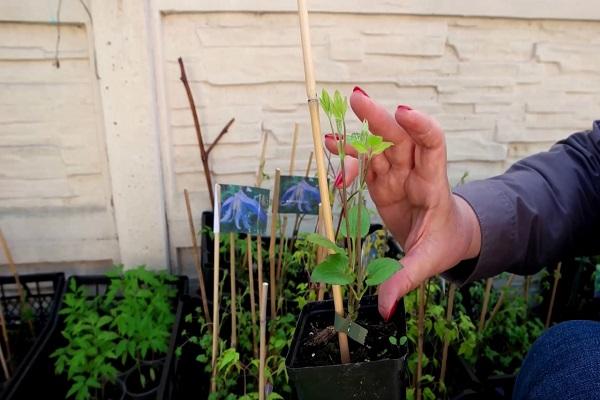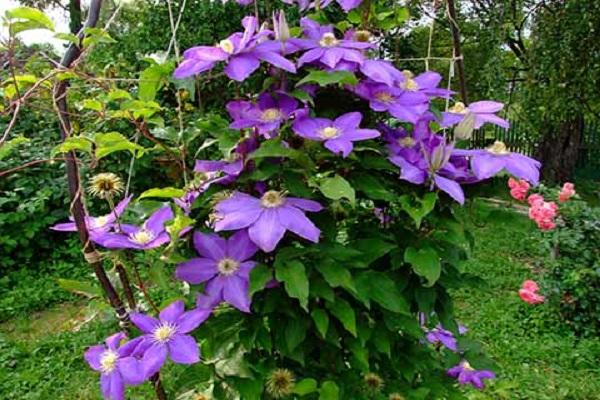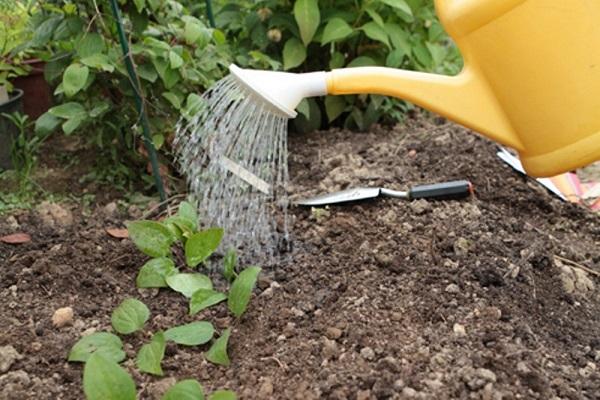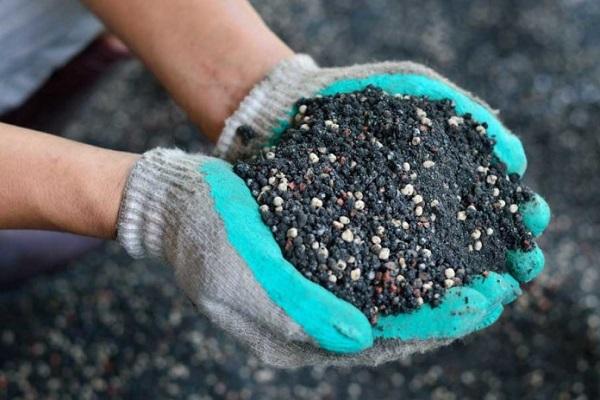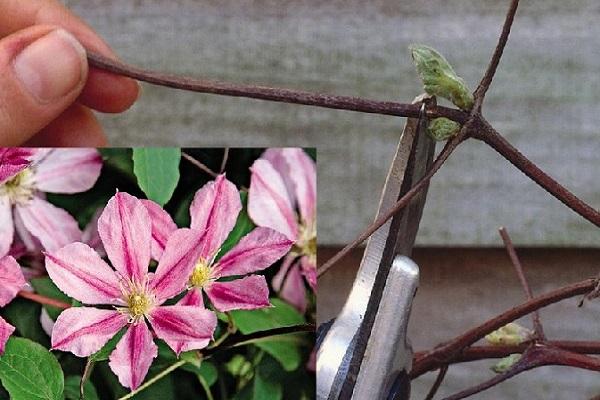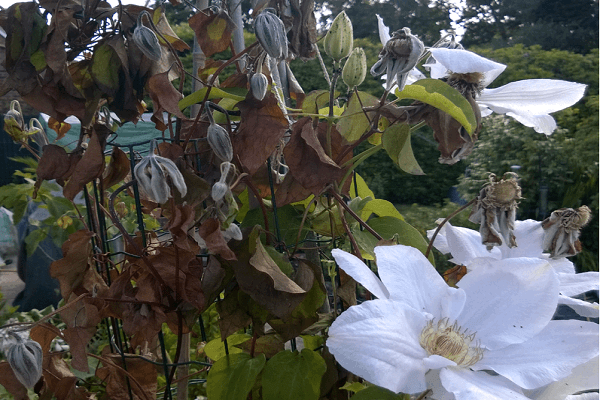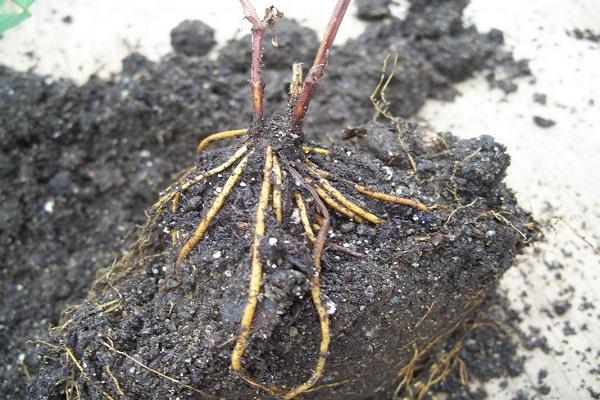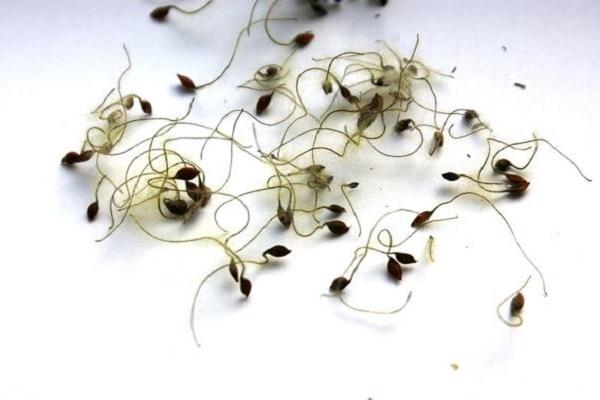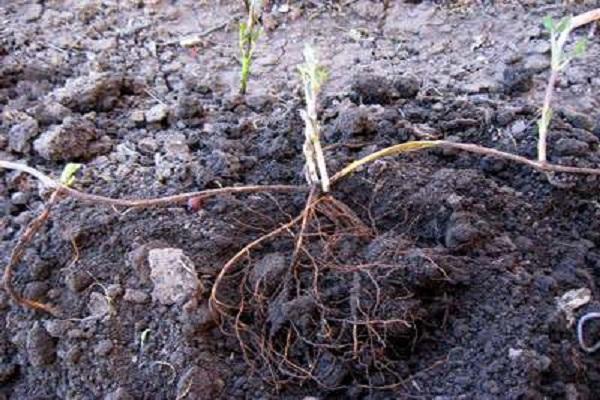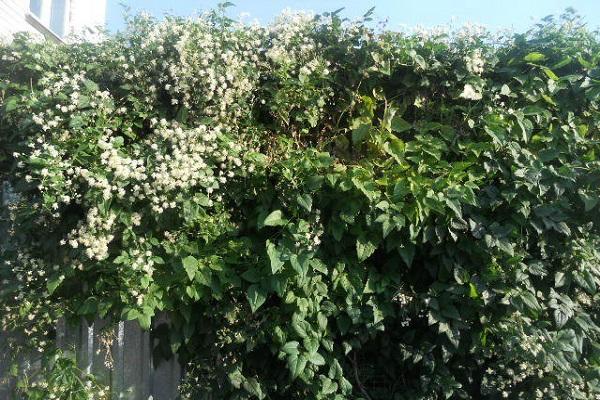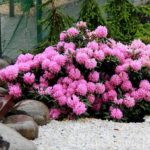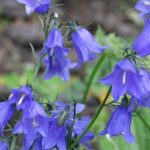Planting and caring for clematis in the Urals requires certain skills from gardeners. To achieve lush flowering and good development of the crop, you should choose the right variety. Compliance with planting rules is of no small importance. In addition, the culture needs to be provided with proper care. It consists of timely watering, pruning, and fertilizing.
- Climatic features of the region
- Winter-hardy species
- Viticella Group
- Jacquemman hybrids
- Integrifolia Group
- Flamula Group
- Popular varieties
- Little Mermaid
- Kaen
- Kakyo
- Daniel Deronda
- Alba Plena
- Rouge Cardinal
- Gypsy Queen
- Bella
- Purple star
- Duran
- Ville de Lyon
- Danuta
- Little Nell
- Masuria
- Royal Velor
- Blue Angel
- Comtes de Boucho
- Space melody
- Blue flame
- Moonlight
- Alyonushka
- Hakura
- Sweet Autumn
- Terniflora
- Planting in open ground
- Deadlines
- Selecting a location
- Selection and storage of planting material
- Planting scheme
- Care
- Watering
- Top dressing
- Trimming
- Garter
- Preparing for winter
- When to open after wintering
- Diseases and pests
- Wither Wilt
- Rust
- Nematode
- Reproduction
- Seeds
- Cuttings
- Layerings
- Dividing the bush
- Plant partners
- Reviews
Climatic features of the region
The Urals are characterized by a rather harsh climate. This region experiences uneven distribution of precipitation, cold winters, and unstable weather conditions in spring and autumn. To achieve success in growing clematis, you should take a responsible approach to the choice of variety..
Winter-hardy species
There are several categories of winter-hardy crops, each of which has certain characteristics.
Viticella Group
These vines are distinguished by their bushy form. The plant is characterized by shoots of 3.5 meters. They appear with complex leaves and beautiful large flowers with a diameter of 12 centimeters. They are usually characterized by red, purple, and pink shades.
Jacquemman hybrids
This category of plants has large flowers and is characterized by a bush form. The length of the shoots reaches 4 meters. They are distinguished by beautiful feathery leaves. This group is also characterized by developed roots.
The diameter of the flowers reaches 20 centimeters. They are predominantly lilac in color.
Integrifolia Group
These are whole-leaved plants that are bushes up to 2.5 meters. The diameter of the flowers reaches 12 centimeters. In appearance they resemble bells. Buds appear on the branches of this year. Therefore, with the arrival of frost, complete pruning is performed.
Flamula Group
This category includes crops of Japanese selection. They have creamy white flowers that are shaped like stars. The liana can reach 3 meters and can withstand frosts down to -34 degrees. It is not recommended to prune the crop for the winter - it is enough to cover the branches.
Popular varieties
Today there are many varieties of clematis known that can be grown in the Urals. This allows each gardener to choose the optimal solution.
Little Mermaid
This is a large-flowered plant. It is characterized by pink inflorescences.
Kaen
This is a Japanese variety with double flowers of a red hue.
Kakyo
Clematis has rich pink flowers with purple stripes.
Daniel Deronda
The plant is characterized by purple inflorescences.
Alba Plena
The culture has unusual light green flowers, which turn white in the sun.
Rouge Cardinal
Clematis is characterized by large dark purple inflorescences.
Gypsy Queen
The plant has large flowers of rich purple color.
Bella
The culture is distinguished by medium-sized inflorescences. They are shaped like a star and have a yellow tint.
Purple star
The culture is characterized by lush flowering and large purple inflorescences.
Duran
The variety has flowers with 4 petals of bright purple color.
Ville de Lyon
The plant is characterized by large flowers of dark red color.
Danuta
The culture has delicate pink flowers.
Little Nell
The variety has flowers with white petals and a delicate purple border.
Masuria
The culture is characterized by double inflorescences of a delicate blue hue.
Royal Velor
The flower has red-purple petals. In the central part you can see a creamy shade.
Blue Angel
The plant is characterized by pale purple inflorescences.
Comtes de Boucho
Clematis of this variety has delicate pink flowers.
Space melody
The plant is characterized by cherry-purple flowers.
Blue flame
The culture has fairly rich inflorescences of a purple hue.
Moonlight
This variety is characterized by a delicate lavender shade of petals.
Alyonushka
The plant has deep pink flowers.
Hakura
This plant of Japanese selection is characterized by white and lilac flowers.
Sweet Autumn
This crop blooms in autumn and is covered with white fragrant inflorescences.
Terniflora
This climbing plant is characterized by fast growth and many white flowers.
Planting in open ground
To grow a crop in the Urals, it is recommended to strictly follow the rules for planting it. To do this, you need to choose the right location and soil composition.
Deadlines
The liana should be planted in open soil in autumn or spring. If the seedling was purchased in late autumn, it is recommended to dig it in until spring and plant it with the onset of warm weather. If the sprout was purchased in the summer and its roots are in a closed container, planting work can be carried out in the fall.
Selecting a location
When planting a plant in the Urals, you should carefully consider the choice of site. The culture is afraid of drafts and cold winds. When choosing a site, you should give preference to dry areas without stagnant water.
If there is a high level of groundwater, a drainage height of at least 20 centimeters is required. For this purpose, broken brick or crushed stone is used. Clematis likes bright areas. Therefore, it is planted in a sunny place, which is reliably protected from the wind.
Selection and storage of planting material
When choosing seedlings, it is worth studying the condition of the root system and above-ground parts. The plant should not have mechanical damage or traces of infectious diseases.If there is a non-healing wound on the crop, one can suspect damage to tinder fungus. It is better to refuse such a purchase.
The rhizomes of seedlings should be carefully examined. The central roots should be covered with small roots and not dried out. They cannot have rot, mold or mechanical damage.
If the main root does not contain lateral branches, such a plant will not take root. If this does happen, the culture will be constantly sick.
Planting scheme
To plant, the plant should be placed in the center of the hole. This is done on a drainage hill. After which it is recommended to carefully distribute the roots and sprinkle with prepared soil. After planting the plant, it is worth compacting the soil a little in the tree trunk area and tying it to a support.
The larger the seedling, the deeper the hole should be. After planting, it is recommended to water the crop with warm water. To prevent damage to the clematis root system by rot, the crop is first watered with water at room temperature..
Care
To ensure full development of the plant, it needs to be properly cared for. To do this, it is worth performing a number of activities.
Watering
For the full development of clematis, proper watering is required. If this procedure is carried out incorrectly, there is a risk of the bush dying. The culture does not like frequent and shallow watering.
Liquid getting into the central part of the bush is especially dangerous. This will lead to damage to the root collar of the plant by rot. In addition, moisture will not get into the soil structure where the roots of the bush are located.
The root system of clematis is considered quite massive. It is located deep, and therefore the crop requires high-quality watering. At one time, an adult plant should receive at least 3 buckets of water.
It is worth watering the crop at intervals of 4 days.In this case, the water should not spread, but get deeper. To do this, you need to make a round hole around the plant at a distance of 40 centimeters from the trunk.
Top dressing
Long-term flowering of the plant requires the application of large amounts of fertilizer. In addition, the culture requires strength to annually renew its shoots. It is worth considering that it is recommended to use fertilizing frequently, but in small volumes. A single introduction of a large amount of fertilizer leads to chemical burns of the root system.
When breeding clematis, it is recommended to alternate organic matter and mineral fertilizers. The bush should be fed at least 4 times during the season. Before using fertilizers, the crop is watered thoroughly. This helps avoid chemical burns.
Before preparing for winter, it is worth adding bone meal. For 1 square meter you will need 200 grams of the substance. During the active growing season, the plant needs the use of nitrogen. If there is a deficiency of this substance, the flowers and leaves will be too small and turn yellow.
The plant needs the use of urea, Nitroammofoska or ammonium nitrate. Potassium nitrate can be added in spring. In warm weather, lime milk is used, which helps prevent soil acidification.
Trimming
The plant must be pruned. This helps to avoid excessive bush density and achieve their rejuvenation. Pruning also makes flowering more abundant. In summer, secondary shoots are cut off from the crop. This activates the appearance of new branches and prolongs flowering.
Almost all varieties of plants stretch upward after planting. Therefore, it is recommended to trim the main stem, leaving only a few strong buds. This activates the emergence of basal stems.
Garter
To ensure normal development of the plant, supports are used.They may have different designs. For this, arches, pyramids or fan compositions are used.
In any case, the thickness of the elements should be no more than 1-1.2 centimeters.
As the shoots grow, they increase their weight. Not all materials can withstand this. When choosing a support, it is not recommended to plant clematis closer than 0.5 meters to a brick wall. The plant should be removed even more from the metal fence. Such structures have a negative impact on the development of culture.
Preparing for winter
When planting clematis in the Urals, you should worry about protecting the plant in winter. With the arrival of cold weather, you need to pour a bucket of humus into the central part of the bush. However, first you should remove the lower leaves from the plant and treat the root collar with copper sulfate. Then the bush is hilled at a height of about 15 centimeters. Ash and sand are used to carry out the procedure.
Covering clematis is allowed only in a dry way. To do this, it is recommended to bend or twist the shoots and then lay them on the base. Then the branches are covered with dry oak leaves, polystyrene foam or spruce branches.
The top of the bush is covered with a box and a piece of roofing felt. You can also use other waterproof material. The structure can be secured with bricks or stones. It should be sprinkled with earth on top.
When to open after wintering
As the snow melts, clematis should be opened. Otherwise the kidneys may dry out. First, you should remove the additional cover - a box and roofing felt. When stable warm weather sets in, you can get rid of the spruce branches.
Immediately after removing the cover, clematis should be watered. 1 bush will require 10-15 liters of water. Instead, you can use a solution using 50 grams of chalk.
Diseases and pests
When growing a plant, it is worth considering that it may encounter various diseases or attacks from harmful insects.
Wither Wilt
This fungal disease often affects plants. During its development, wilting and drying of leaves and shoots is observed. Special means help to cope with the problem - for example, Fundazol. In case of severe damage, the plant must be removed with a lump of earth. After which it is recommended to disinfect the planting area.
Rust
This is a rather unpleasant pathology, which is accompanied by the appearance of yellow and brown spots on the leaves. Bordeaux mixture helps to cope with the disease.
Nematode
These pests lead to damage to shoots, leaves, and flowers. Systemic insecticides help to cope with them.
Reproduction
Clematis can be propagated in different ways - by seeds, dividing the bush, layering or cuttings.
Seeds
This method is suitable for propagating only small flowers. Other plants require the use of vegetative methods.
Seeds should be collected this year or you can purchase material in special stores. Before planting in the ground, the seeds should be soaked in water for 10 days. The water should be changed constantly. Otherwise, it will not be possible to achieve stable growth.
Then you should prepare containers for sowing. They are filled with a high-quality mixture based on soil, peat and sand. The soil should be moistened, then the seeds should be spread over its surface and sprinkled with sand.
Cover the containers with film or glass and place in a warm room. When 2 true leaves appear, the plants are transplanted into separate containers. After 3 years, the seedling can be transferred to a permanent place.
Cuttings
To propagate the crop by cuttings, you need to prepare planting material 8-12 centimeters long. Immerse the cuttings in a growth stimulator for 24 hours. Plant the material in the greenhouse and cover with jars. Before roots appear, the soil should be moistened. When roots form, the cuttings are planted in open ground.
Layerings
To successfully carry out the procedure in the fall, you should select the healthiest shoots at the bottom of the bush and clear them of leaves. Collect several branches, bend them and place them in the trench. Carefully secure them and cover them with soil.
For the winter, cover the plant with leaves and spruce branches. In the spring, the crop should be provided with enhanced care, and in the fall, the shoots should be separated from the mother plant.
Dividing the bush
This method is worth propagating varieties with fibrous rhizomes. You can divide the bush in the spring. However, it is best to do this in the fall. To carry out the procedure, you should dig up the bush with careful movements so as not to injure the roots. Shake off the soil and use a sharp knife to divide into several fragments.
Plant partners
Clematis goes well with other climbing crops. They can be combined with virgin grapes or campsis. You can also use annual vines - thunbergia, moonflower.
Clematis also goes well with roses. Below you can plant low annual plants and evergreen bushes. Lawn grass looks impressive or brightyellow evening primroses.
Reviews
Numerous reviews indicate the popularity of this plant in the Urals:
- Anna: “I planted the Duran variety in the garden. I really liked the result. The flower is quite unpretentious. I have to cover it for the winter, but otherwise there are no problems.”
- Svetlana: “I chose the most popular variety in the Urals - Ville de Lyon.Indeed, a very good plant that is resistant to frost and disease.”
Clematis are spectacular plants that can be grown in the Urals. To achieve good results, you need to choose the right variety and provide it with complete and comprehensive care.

